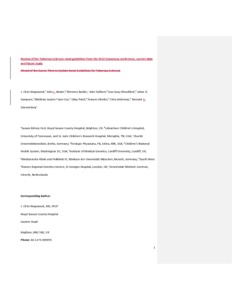Kingswood, JC;
Bissler, JJ;
Budde, K;
Hulbert, J;
Guay-Woodford, L;
Sampson, JR;
Sauter, M;
Cox, J;
Patel, U;
Elmslie, F;
et al.
Kingswood, JC; Bissler, JJ; Budde, K; Hulbert, J; Guay-Woodford, L; Sampson, JR; Sauter, M; Cox, J; Patel, U; Elmslie, F; Anderson, C; Zonnenberg, BA
(2016)
Review of the Tuberous Sclerosis Renal Guidelines from the 2012 Consensus Conference: Current Data and Future Study.
Nephron, 134 (2).
pp. 51-58.
ISSN 2235-3186
https://doi.org/10.1159/000448293
SGUL Authors: Elmslie, Frances
![[img]](https://openaccess.sgul.ac.uk/110992/1.hassmallThumbnailVersion/Review_of_the_tuberous_sclerosis_renal_guidelines.pdf)  Preview |
|
PDF
Accepted Version
Available under License ["licenses_description_publisher" not defined].
Download (230kB)
| Preview
|
Abstract
Renal-related disease is the most common cause of tuberous sclerosis complex (TSC)-related death in adults, and renal angiomyolipomas can lead to complications that include chronic kidney disease (CKD) and hemorrhage. International TSC guidelines recommend mammalian target of rapamycin (mTOR) inhibitors as first-line therapy for management of asymptomatic, growing angiomyolipomas >3 cm in diameter. This review discusses data regarding patient outcomes that were used to develop current guidelines for embolization of renal angiomyolipomas and presents recent data on 2 available mTOR inhibitors - sirolimus and everolimus - in the treatment of angiomyolipoma. TSC-associated renal angiomyolipomas can recur after embolization. Both sirolimus and everolimus have shown effectiveness in reduction of angiomyolipoma volume, with an acceptable safety profile that includes preservation of renal function with long-term therapy. The authors propose a hypothesis for mTORC1 haploinsufficiency as an additional mechanism for CKD and propose that preventive therapy with mTOR inhibitors might have a role in reducing the number of angiomyolipoma-related deaths. Because mTOR inhibitors target the underlying pathophysiology of TSC, patients might benefit from treatment of multiple manifestations with one systemic therapy. Based on recent evidence, new guidelines should be considered that support the earlier initiation of mTOR inhibitor therapy for the management of renal angiomyolipomas to prevent future serious complications, rather than try to rescue patients after the complications have occurred.
| Item Type: |
Article
|
| Additional Information: |
This is the peer-reviewed but unedited manuscript version of the following article: Nephron 2016;134:51-58 (DOI:10.1159/000448293). The final, published version is available at http://www.karger.com/?doi=10.1159/000448293 |
| Keywords: |
Adult, Angiomyolipoma, Consensus, Humans, Kidney Neoplasms, Practice Guidelines as Topic, TOR Serine-Threonine Kinases, Tuberous Sclerosis, Humans, Tuberous Sclerosis, Angiomyolipoma, Kidney Neoplasms, Consensus, Adult, Practice Guidelines as Topic, TOR Serine-Threonine Kinases, Tuberous sclerosis complex, Angiomyolipoma, Embolization, Mammalian target of rapamycin inhibitors, Everolimus, Sirolimus, Renal complications, Prevention, Treatment guidelines, 1116 Medical Physiology, 1103 Clinical Sciences, Urology & Nephrology |
| Journal or Publication Title: |
Nephron |
| ISSN: |
2235-3186 |
| Language: |
eng |
| Dates: |
| Date | Event |
|---|
| October 2016 | Published | | 10 August 2016 | Published Online | | 6 July 2016 | Accepted |
|
| Publisher License: |
Publisher's own licence |
| PubMed ID: |
27504842 |
| Web of Science ID: |
WOS:000384951700001 |
 |
Go to PubMed abstract |
| URI: |
https://openaccess.sgul.ac.uk/id/eprint/110992 |
| Publisher's version: |
https://doi.org/10.1159/000448293 |
Statistics
Item downloaded times since 02 Jul 2019.
Actions (login required)
 |
Edit Item |



